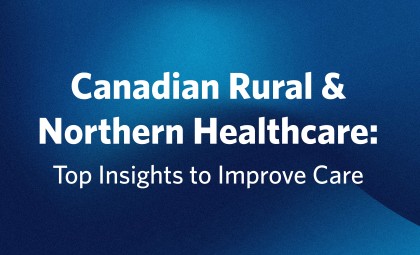Canadian Rural & Northern Healthcare: Top Insights to Improve Care

Healthcare in rural and northern regions has its own unique challenges. The Canadian Rural & Northern Healthcare Leadership Conference, hosted by Spark Conferences, provides a forum for idea exchange and knowledge-sharing to tackle these challenges.
HIROC is proud to support this annual event as an Education Partner.
We at HIROC value partnering with the healthcare community, taking time to listen, but most importantly, capturing and sharing the valuable insights from all the healthcare change makers who presented at this year’s event.
Here's just a few of the many takeaways from the amazing speakers.
1. Transition and change management
Debbie Walsh, Vice-President and Chief Operating Officer for the Eastern Rural Zone at Newfoundland and Labrador (NL) Health Services, shared key aspects of transition and change management from NL Health Services’ large-scale transition to one provincial health authority. She emphasized the importance of communicating everything from operational matters to high-level strategic discussions with staff throughout the transition.
Key aspects of the transition included:
- Human resource planning
- Organizational design principles
- Regular management and all staff meetings (done in both daytime and evenings to communicate with frontline staff)
- Organizational chart
- Employee survey on branding
- Engagement sessions with healthcare staff
- New leadership team
2. How to engage rural communities
Debbie also spoke about the ways NL Health Services engaged with their local communities during their transition.
Methods included:
- Reaching out to each of the health authority’s regional zones both individually and collectively
- Meeting with town councils, mayors, academia (including Memorial University), and government
- Talking to media
- Offering to meet with individuals and groups who reached out
- Engaging key external stakeholders and encouraging questions
3. Leadership approaches for healthcare leaders
Robert Alldred-Hughes, President & CEO of Hôpital Glengarry Memorial Hospital in eastern Ontario, shared different leadership approaches and how they play a pivotal role in shaping organizational culture. He noted that these leadership styles are critical, especially for rural hospitals: democratic, collaborative, adaptable, inspirational, and servant leadership.
“Think about your bad bosses and what they taught you not to do,” Robert quipped.
He offered up a number of leadership principles for healthcare leaders:
- Engage with patient advocates and political leaders (including local politicians)
- Keep a holistic view of healthcare (i.e., what part are we playing to support primary care)
- Build relations with local media
- Lead by walking around (e.g., get to know teams, their pain points, how you can help staff, know what’s happening within your organization)
- Balance staff and patient satisfaction
- Be present and visible in community (e.g., go to local events)
- Remember that you’re the barometer for your teams (e.g., staff look to you for leadership and advice)
4. Nurse retention factors and improvement
Nathan Banda, Researcher and Director Surgical Services at Grande Prairie Regional Hospital in Alberta, shared the results of his research on factors that affect nurse retention in rural Canada. He separated his findings into two categories: nurses’ intention to stay at their jobs (NITS) and nurses’ intention to leave (NITL).
The main factors contributing to NITS were:
- Family and social support
- Family needs in community
- Approachability and support of charge nurses
- Good and supportive team
- Variety of patient conditions requiring different skills making work interesting
The main factors contributing to NITL were:
- Heavy workload with high nurse-to-patient ratios
- Poor relations among staff onsite
- Lack of management support
- Inadequate orientation and development days
- Perception of managers being overwhelmed
Notable are that most NITL causes were internal rather than external, and there’s a direct relationship between managers’ and nurses’ retention (high manager turnover contributes to high nurse turnover).
Practical recommendations to tackle these NITL factors are:
- Standardize patient-to-nurse ratios
- Hire more healthcare aids to reduce nurse workload
- Ensure safe and respectful workplace
- Regularly meet with leadership and managers
- Hold annual development conversations with frontline staff
- Standardize orientation for staff
Bonus learnings
During Nathan’s Q&A, many lessons learned were shared by those in the audience. For example, Debbie from NL Health Services shared their strategies for improving nurse retention, and they are very similar to Nathan’s research recommendations proving their practicality.
Debbie explained NL Health Services has adopted the following strategies:
- Integrated capacity management based on acuity of patient not the number of patients per nurse
- Increased scope of practice for licensed practical nurses or nurse assistants so they are able to provide more care and reduce nurse workload
- Introduced shorter, casual performance discussions alleviating the formalities of traditional touchpoints
- Began gradual employee orientations that happen over the course of a longer period of time (e.g., months or a year) with new employees rotating through and spending time in each facility area since specific orientation days may use too many resources
Two days of collaboration and connection
At the end of the two-day conference, the capacity in-person audience as well as those tuning in virtually walked away hearing more about:
- Transition and change management lessons
- Importance of engaging rural communities
- Valuable leadership approaches
- Insightful factors attributing to nurse retention
“It was great hearing firsthand experiences. I’m fortunate to work with so many of our Subscribers, and getting a deeper understanding of the evolving needs of rural and northern healthcare communities allows us to better tailor our risk and insurance advice, ensuring we continue to meet their needs.”
- Jodi Carruthers, Senior Healthcare Risk Management Specialist at HIROC and participant at the event
By Gillian Brandon-Hart, Communications and Marketing Specialist, HIROC